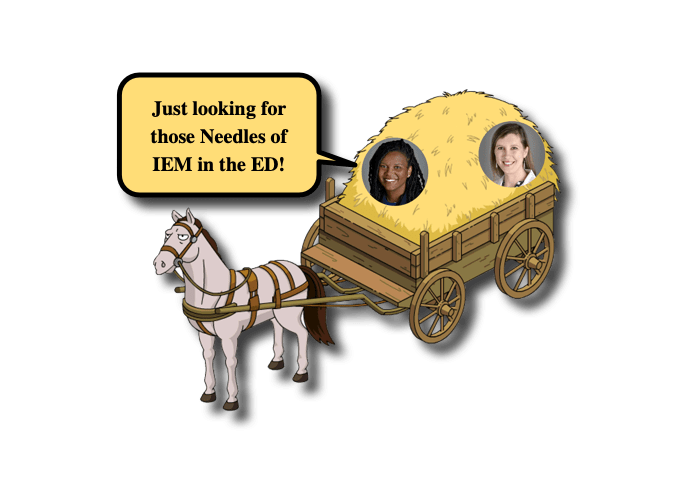Rebaked: Inborn Errors of Metabolism presenting in the ED

Often our job requires us to consider the presence of needles of significant illness in the haystack of nonspecific symptoms. With the help of our favorite geneticist, Dr. Liz Baker, we will dive into the haystack headfirst and find those needles. Hopefully, without getting poked. Let’s consider Inborn Errors of Metabolism Presenting in the ED:
Inborn Errors of Metabolism: Basics
Common Presentations, Uncommon Kiddos
- For the child with lethargy, vomiting, acidosis, hypoglycemia, organomegaly, or cardiopulmonary arrest remember to consider Inborn Errors of Metabolism (IEM) on your DDx.
- To keep things simple, IEM is characterized by the inability to break down macromolecules (fatty acids, carbohydrates, and proteins) or store energy (glycogen).
- Timing of Presentation / Diagnosis:
- For severe forms of IEM will present in the first few days of life—before the newborn screen is back!
- For moderate forms of IEM, those who cannot efficiently use macromolecules to make energy, will present with failure to thrive and developmental delay in infancy and early childhood.
- For milder forms of IEM, children can compensate until the body is under stress and may recover after stress (leading to delayed diagnosis).
- Common catabolic riggers include:
- Infection
- Kids with IEM can also get common infections, like Acute Otitis Media.
- Viral infections also may cause metabolic stress.
- Dehydration
- Surgery
- Pregnancy (If we don’t ask we don’t know)
- Infection
- Many important IEM are included in the Newborn Screen.
- Newborn screening (NBS) is a state-based public health program in the United States.
- Each state creates their own screen, and may differ substantially between states.
- Find out what your state includes here.
Kid with Known diagnosis? DO NOT WING IT!
- If a child has a known IEM, it is not the time to be a cowgirl or cowboy.
- Ask for their emergency letter and/or review their last genetics office note.
- Each disorder has specific needs, require specific fluids, and specific medications to prevent them from spiraling i.e. some need L-carnitine supplementation.
Inborn Errors of Metabolism: What to Do!
What to Order, In that Order
- When a patient presents with a presentation concerning for a new onset metabolic crisis, it’s important to know what to do!
- To assess how severe the metabolic crisis is, prioritize these labs
- POC glucose
- VBG
- CMP
- Urinalysis (UA)
- Ammonia, free flowing
- Sometimes, it is really challenging to perform blood draws in littles ones.
- Nursing will frequently “milk” the line which can falsely elevate the ammonia.
- It is important to have a free-flowing sample to get the most accurate ammonia level.
- Don’t forget to send STAT on ICE.

Other helpful considerations:
- Identify the catabolic trigger
- Thorough history and exam (always important!)
- CBC, Blood and Urine Cultures, and Respiratory Pathogen Panel (RPP)
- Draw the extra blood. Your genetics and inpatient colleagues will thank you!
- If the patient presents in metabolic crisis and the exact diagnosis is not known, ED providers can send additional labs to help expedite the work up by obtaining :
- Plasma amino acids,
- Acylcarnitine profile, and
- Urine organic acids
- If the patient presents in metabolic crisis and the exact diagnosis is not known, ED providers can send additional labs to help expedite the work up by obtaining :
Management
- Goal: we want to stop the metabolic crisis and convert anabolism
- Remember your ABCs and O MI Sugar for your critically ill kiddos
- Airway
- Breathing
- Circulation
- Oxygen
- Monitors
- IV access
- Sugar aka glucose
- Send your labs STAT
- Keep the patient NPO
- If the child has an enzyme deficiency, toxic substrates could accumulate and worsen the metabolic crisis… STOP THE CYCLE
- Dextrose containing fluids, preferably D10, at 1.5x maintenance
- Your patient needs a consistent source of substrate to make energy
- Our goal is to convert them from catabolism to anabolism
- Find the trigger
- Perform a thorough history and physical
- Rule out sepsis
- Early consultation with a geneticist or tertiary children’s hospital
- Admission is the default
- Discharge planning should be discussed with the subspecialty team
Moral of the Morsel
- Thank kid is sick! Then please put IEM on your differential for critically ill newborns and infants
- Kids should be Sweet! Keep patients NPO and give dextrose containing fluids (not just a bolus of saline)!
- Friends are helpful! Talk to the Sub-specialists! The patient’s sub-specialist will know if the patient has other specific factors that increase or decrease their risk.
- Don’t trust them. Admission is the default. There may be an occasion when a patient is lower risk that the sub-specialist is comfortable treating as an outpatient, but realize they are not NO risk.
References:
Applegarth DA, Toone JR, Lowry RB. Incidence of inborn errors of metabolism in British Columbia, 1969–1996. Pediatrics. 2000;105:e10.
Inborn Errors of Metabolism: Becoming Ready for Rare. Samantha A. Schrier Vergano. Pediatr Rev (2022) 43 (7): 371–383. https://doi.org/10.1542/pir.2022-005088

